Effects of Topography and Social Position on the Solar Radiation of Individual Trees on a Hillslope in Northwest China
Abstract
1. Introduction
2. Materials and Methods
2.1. Study Site
2.2. Study Slope and Plots
2.2.1. Study Slope
2.2.2. Study Plots
2.3. Social Position of Trees in the Forest
2.4. Sample Tree Selection from the down Slope Plot (DS)
2.5. Solar Radiation Measurement
2.5.1. Solar Radiation Data Conversion
2.5.2. Solar Radiation of Individual Trees
2.5.3. Solar Radiation over the Forest Canopy
2.5.4. Solar Radiation at the Horizontal Ground Measurement
2.6. The Calculation of Solar Radiation on a Single Hillslope
2.7. Relative Contribution of ΔH/Δd, R, Dom and D to Solar Radiation Received by an Individual Tree
2.8. Statistical Analysis
3. Results
3.1. Variation of Solar Radiation at Different Slope Positions
3.2. Effect of Tree Social Position on Its Solar Radiation
3.3. The Construction of the Tree Solar Radiation Model and Its Validation
3.4. Independent Contributions of ΔH/Δd, Rh, Dom and D to Ri
4. Discussion
4.1. The Role of Topography on Solar Radiation: Slope Effect and Shaded Terrain Effect
4.2. The Distance among Trees Was the Dominant Factor for Tree Solar Radiation
4.3. Applications of the Newly Developed Ri Model
4.4. Implications for Mountain Forest Management
4.5. Limitations of This Study
5. Conclusions
Author Contributions
Funding
Data Availability Statement
Acknowledgments
Conflicts of Interest
References
- Smith, H. Light Quality, Photoperception, and Plant Strategy. Annu. Rev. Plant Physiol. 1982, 33, 481–518. [Google Scholar] [CrossRef]
- Chiang, C.; Olsen, J.E.; Basler, D.; Bånkestad, D.; Hoch, G. Latitude and Weather Influences on Sun Light Quality and the Relationship to Tree Growth. Forests 2019, 10, 610. [Google Scholar] [CrossRef]
- Sinoquet, H.; Rakocevic, M.; Varlet-Grancher, C. Comparison of Models for Daily Light Partitioning in Multispecies Canopies. Agric. For. Meteorol. 2000, 101, 251–263. [Google Scholar] [CrossRef]
- Wang, H.; Tetzlaff, D.; Dick, J.J.; Soulsby, C. Assessing the Environmental Controls on Scots Pine Transpiration and the Implications for Water Partitioning in a Boreal Headwater Catchment. Agric. For. Meteorol. 2017, 240–241, 58–66. [Google Scholar] [CrossRef]
- Lu, Y.; Lei, X.; Hong, L.; Ning, J.; Liu, X.; Meng, J. Demonstrative Application of the Close-to-Nature Forest Management Planning System to Forestry Practice. J. Southwest For. Univ. 2010, 30, 1–6. [Google Scholar]
- Binkley, D.; Stape, J.L.; Bauerle, W.L.; Ryan, M.G. Explaining Growth of Individual Trees: Light Interception and Efficiency of Light Use by Eucalyptus at Four Sites in Brazil. For. Ecol. Manag. 2010, 259, 1704–1713. [Google Scholar] [CrossRef]
- Binkley, D.; Campoe, O.C.; Gspaltl, M.; Forrester, D.I. Light Absorption and Use Efficiency in Forests: Why Patterns Differ for Trees and Stands. For. Ecol. Manag. 2013, 288, 5–13. [Google Scholar] [CrossRef]
- Oogathoo, S.; Houle, D.; Duchesne, L.; Kneeshaw, D. Vapour Pressure Deficit and Solar Radiation Are the Major Drivers of Transpiration of Balsam Fir and Black Spruce Tree Species in Humid Boreal Regions, Even during a Short-Term Drought. Agric. For. Meteorol. 2020, 291, 108063. [Google Scholar] [CrossRef]
- Rissanen, K.; Martin-Guay, M.-O.; Riopel-Bouvier, A.-S.; Paquette, A. Light Interception in Experimental Forests Affected by Tree Diversity and Structural Complexity of Dominant Canopy. Agric. For. Meteorol. 2019, 278, 107655. [Google Scholar] [CrossRef]
- Fu, B. The total amount of solar radiation on the slope. J. Nanjing Univ. (Nat. Sci.) 1958, 02, 47–82. [Google Scholar]
- Prévost, M.; Raymond, P. Effect of Gap Size, Aspect and Slope on Available Light and Soil Temperature after Patch-Selection Cutting in Yellow Birch–Conifer Stands, Quebec, Canada. For. Ecol. Manag. 2012, 274, 210–221. [Google Scholar] [CrossRef]
- Baek, S.C.; Park, J.-H.; Na, S.I.; Park, J.-K. Distribution of Solar Radiation Including Slope Effect in South Korea. In Proceedings of the International Society for Optical Engineering; Entekhabi, D., Honda, Y., Sawada, H., Shi, J., Oki, T., Eds.; Kyoto, Japan, 21 November 2012; p. 85242K. Available online: https://www.spiedigitallibrary.org/conference-proceedings-of-spie/8524/1/Distribution-of-solar-radiation-including-slope-effect-in-South-Korea/10.1117/12.977420.short?SSO=1 (accessed on 22 February 2023).
- Chen, J.M.; Chen, X.; Ju, W. Effects of Vegetation Heterogeneity and Surface Topography on Spatial Scaling of Net Primary Productivity. Biogeosciences 2013, 10, 4879–4896. [Google Scholar] [CrossRef]
- Aakala, T.; Shimatani, K.; Abe, T.; Kubota, Y.; Kuuluvainen, T. Crown Asymmetry in High Latitude Forests: Disentangling the Directional Effects of Tree Competition and Solar Radiation. Oikos 2016, 125, 1035–1043. [Google Scholar] [CrossRef]
- Fan, W.; Chen, J.M.; Weimin, J.; Nesbitt, N. Hybrid Geometric Optical–Radiative Transfer Model Suitable for Forests on Slopes. IEEE Trans. Geosci. Remote Sens. 2014, 52, 5579–5586. [Google Scholar] [CrossRef]
- Nath, B.; Ni-Meister, W. The Interplay between Canopy Structure and Topography and Its Impacts on Seasonal Variations in Surface Reflectance Patterns in the Boreal Region of Alaska—Implications for Surface Radiation Budget. Remote Sens. 2021, 13, 3108. [Google Scholar] [CrossRef]
- Zhang, X. Effects of Social Position and Competition on Tree Transpiration of a Natural Mixed Forest in Chongqing, China. Trees 2019, 33, 719–732. [Google Scholar] [CrossRef]
- Garg, H.P.; Datta, G. Fundamentals and Characteristics of Solar Radiation. Renew. Energy 1993, 3, 305–319. [Google Scholar] [CrossRef]
- Gracia, M.; Montané, F.; Piqué, J.; Retana, J. Overstory Structure and Topographic Gradients Determining Diversity and Abundance of Understory Shrub Species in Temperate Forests in Central Pyrenees (NE Spain). For. Ecol. Manag. 2007, 242, 391–397. [Google Scholar] [CrossRef]
- Liu, B.; Yang, J.; Johnstone, J.F. Understory Vascular Plant Community Assembly in Relation to Time-since-Fire and Environmental Variables in a Chinese Boreal Forest. J. Mt. Sci. 2017, 14, 1317–1328. [Google Scholar] [CrossRef]
- Díaz, F.; Montero, H.; Santana, D.; Montero, G.; Rodríguez, E.; Mazorra Aguiar, L.; Oliver, A. Improving Shadows Detection for Solar Radiation Numerical Models. Appl. Math. Comput. 2018, 319, 71–85. [Google Scholar] [CrossRef]
- Courbaud, B.; de Coligny, F.; Cordonnier, T. Simulating Radiation Distribution in a Heterogeneous Norway Spruce Forest on a Slope. Agric. For. Meteorol. 2003, 116, 1–18. [Google Scholar] [CrossRef]
- Warren, R.J. Mechanisms Driving Understory Evergreen Herb Distributions across Slope Aspects: As Derived from Landscape Position. Plant Ecol. 2008, 198, 297–308. [Google Scholar] [CrossRef]
- Zhang, Y.; Chang, X.; Liang, J. Comparison of Different Algorithms for Calculating the Shading Effects of Topography on Solar Irradiance in a Mountainous Area. Environ. Earth Sci. 2017, 76, 295. [Google Scholar] [CrossRef]
- Olson, M.; Rupper, S. Impacts of Topographic Shading on Direct Solar Radiation for Valley Glaciers in Complex Topography. Cryosphere 2019, 13, 29–40. [Google Scholar] [CrossRef]
- Remeš, J.; Bílek, L.; Novák, J.; Vacek, Z.; Vacek, S.; Putalová, T.; Koubek, L. Diameter Increment of Beech in Relation to Social Position of Trees, Climate Characteristics and Thinning Intensity. J. For. Sci. 2015, 61, 456–464. [Google Scholar] [CrossRef]
- Grote, R.; Gessler, A.; Hommel, R.; Poschenrieder, W.; Priesack, E. Importance of Tree Height and Social Position for Drought-Related Stress on Tree Growth and Mortality. Trees 2016, 30, 1467–1482. [Google Scholar] [CrossRef]
- Zhang, S.Y.; Ren, H.; Jiang, Z. Wood Density and Wood Shrinkage in Relation to Initial Spacing and Tree Growth in Black Spruce (Picea Mariana). J. Wood Sci. 2021, 67, 30. [Google Scholar] [CrossRef]
- Campoe, O.C.; Stape, J.L.; Albaugh, T.J.; Lee Allen, H.; Fox, T.R.; Rubilar, R.; Binkley, D. Fertilization and Irrigation Effects on Tree Level Aboveground Net Primary Production, Light Interception and Light Use Efficiency in a Loblolly Pine Plantation. For. Ecol. Manag. 2013, 288, 43–48. [Google Scholar] [CrossRef]
- Gspaltl, M.; Bauerle, W.; Binkley, D.; Sterba, H. Leaf Area and Light Use Efficiency Patterns of Norway Spruce under Different Thinning Regimes and Age Classes. For. Ecol. Manag. 2013, 288, 49–59. [Google Scholar] [CrossRef]
- Warren, C.R.; McGrath, J.F.; Adams, M.A. Water Availability and Carbon Isotope Discrimination in Conifers. Oecologia 2001, 127, 476–486. [Google Scholar] [CrossRef] [PubMed]
- Hale, S.E. The Effect of Thinning Intensity on the Below-Canopy Light Environment in a Sitka Spruce Plantation. For. Ecol. Manag. 2003, 179, 341–349. [Google Scholar] [CrossRef]
- Wan, Y.; Yu, P.; Wang, Y.; Wang, B.; Yu, Y.; Wang, X.; Liu, Z.; Liu, X.; Wang, S.; Xiong, W. The Variation in Water Consumption by Transpiration of Qinghai Spruce among Canopy Layers in the Qilian Mountains, Northwestern China. Forests 2020, 11, 845. [Google Scholar] [CrossRef]
- Campoe, O.C.; Stape, J.L.; Nouvellon, Y.; Laclau, J.-P.; Bauerle, W.L.; Binkley, D.; Maire, G.L. Stem Production, Light Absorption and Light Use Efficiency between Dominant and Non-Dominant Trees of Eucalyptus Grandis across a Productivity Gradient in Brazil. For. Ecol. Manag. 2013, 288, 14–20. [Google Scholar] [CrossRef]
- Fernández-Tschieder, E.; Binkley, D.; Bauerle, W. Production Ecology and Reverse Growth Dominance in an Old-Growth Ponderosa Pine Forest. For. Ecol. Manag. 2020, 460, 117891. [Google Scholar] [CrossRef]
- Li, S. Forest in Mountainous Ecosystem and Its Relationship with Production. Chin. J. Ecol. 1985, 35–38. [Google Scholar]
- Tian, A.; Wang, Y.; Webb, A.A.; Liu, Z.; Yu, P.; Xiong, W.; Wang, X. Partitioning the Causes of Spatiotemporal Variation in the Sunny Day Sap Flux Density of a Larch Plantation on a Hillslope in Northwest China. J. Hydrol. 2019, 571, 503–515. [Google Scholar] [CrossRef]
- Kübler, D.; Hildebrandt, P.; Günter, S.; Stimm, B.; Weber, M.; Muñoz, J.; Cabrera, O.; Zeilinger, J.; Silva, B.; Mosandl, R. Effects of Silvicultural Treatments and Topography on Individual Tree Growth in a Tropical Mountain Forest in Ecuador. For. Ecol. Manag. 2020, 457, 117726. [Google Scholar] [CrossRef]
- Wang, L.; Liu, Z.; Guo, J.; Wang, Y.; Ma, J.; Yu, S.; Yu, P.; Xu, L. Estimate Canopy Transpiration in Larch Plantations via the Interactions among Reference Evapotranspiration, Leaf Area Index, and Soil Moisture. For. Ecol. Manag. 2021, 481, 118749. [Google Scholar] [CrossRef]
- Liu, Z.; Wang, Y.; Yu, P.; Xu, L.; Yu, S. Environmental and Canopy Conditions Regulate the Forest Floor Evapotranspiration of Larch Plantations. For. Ecosyst. 2022, 9, 100058. [Google Scholar] [CrossRef]
- Liu, Z.; Wang, Y.; Tian, A.; Yu, P.; Xiong, W.; Xu, L.; Wang, Y. Intra-Annual Variation of Stem Radius of Larix Principis-Rupprechtii and Its Response to Environmental Factors in Liupan Mountains of Northwest China. Forests 2017, 8, 382. [Google Scholar] [CrossRef]
- Fu, B. The Influence of Slope on the Sunniness. J. Nanjing Univ. (Nat. Sci.) 1958, 02, 23–46. [Google Scholar]
- Schmidt, U.; Thöni, H.; Kaupenjohann, M. Using a Boundary Line Approach to Analyze N2O Flux Data from Agricultural Soils. Nutr. Cycl. Agroecosystems 2000, 57, 119–129. [Google Scholar] [CrossRef]
- Liu, Z.; Wang, Y.; Tian, A.; Webb, A.A.; Yu, P.; Xiong, W.; Xu, L.; Wang, Y. Modeling the Response of Daily Evapotranspiration and Its Components of a Larch Plantation to the Variation of Weather, Soil Moisture, and Canopy Leaf Area Index. J. Geophys. Res. Atmos. 2018, 123, 7354–7374. [Google Scholar] [CrossRef]
- Sun, Z.; Shi, B.; Weng, D. Distribution characteristics of direct solar radiation on mountain slopes in China. Plateau Meteorol. 1990, 9, 371–381. [Google Scholar]
- Zeng, Y.; Qiu, X.; Pan, A.; Liu, C. Distributed Modeling of Global Solar Radiation over Rugged Terrain of the Yellow River Basin. Adv. Earth Sci. 2008, 23, 1185–1193. [Google Scholar]
- Zhang, S.; Li, X.; She, J. Error Assessment of Grid-based Terrain Shading Algorithms for Solar Radiation Modeling over Complex Terrain. Trans. GIS 2020, 24, 230–252. [Google Scholar] [CrossRef]
- Shi, G.; Qiu, X.; Zeng, Y. New Method for Estimating Daily Global Solar Radiation over Sloped Topography in China. Adv. Atmos. Sci. 2018, 35, 285–295. [Google Scholar] [CrossRef]
- Aguilar, C.; Herrero, J.; Polo, M.J. Topographic Effects on Solar Radiation Distribution in Mountainous Watersheds and Their Influence on Reference Evapotranspiration Estimates at Watershed Scale. Hydrol. Earth Syst. Sci. 2010, 14, 2479–2494. [Google Scholar] [CrossRef]
- Marsh, C.B.; Pomeroy, J.W.; Spiteri, R.J. Implications of Mountain Shading on Calculating Energy for Snowmelt Using Unstructured Triangular Meshes: Implications of Mountain Shading for Snowmelt. Hydrol. Process. 2012, 26, 1767–1778. [Google Scholar] [CrossRef]
- Laurans, M.; Hérault, B.; Vieilledent, G.; Vincent, G. Vertical Stratification Reduces Competition for Light in Dense Tropical Forests. For. Ecol. Manag. 2014, 329, 79–88. [Google Scholar] [CrossRef]
- Chase, C.W.; Kimsey, M.J.; Shaw, T.M.; Coleman, M.D. The Response of Light, Water, and Nutrient Availability to Pre-Commercial Thinning in Dry Inland Douglas-Fir Forests. For. Ecol. Manag. 2016, 363, 98–109. [Google Scholar] [CrossRef]
- Strand, M.; Löfvenius, M.O.; Bergsten, U.; Lundmark, T.; Rosvall, O. Height Growth of Planted Conifer Seedlings in Relation to Solar Radiation and Position in Scots Pine Shelterwood. For. Ecol. Manag. 2006, 224, 258–265. [Google Scholar] [CrossRef]
- Chi, X.; Tang, Z.; Xie, Z.; Guo, Q.; Zhang, M.; Ge, J.; Xiong, G.; Fang, J. Effects of Size, Neighbors, and Site Condition on Tree Growth in a Subtropical Evergreen and Deciduous Broad-leaved Mixed Forest, China. Ecol. Evol. 2015, 5, 5149–5161. [Google Scholar] [CrossRef]
- Huang, D.; Qian, Y. The effects of the slope irradiance on different weather processes under different model resolutions. Acta Meteorol. Sin. 2008, 01, 90–100. [Google Scholar]
- Choosakul, N.; Buddhakala, M.; Barnthip, N.; Muakngam, A.; Banglieng, C. Application of Solar Cells for Daytime Weather Study. Energy Procedia 2011, 9, 171–177. [Google Scholar] [CrossRef]
- Hassan-Esfahani, L.; Torres-Rua, A.; Jensen, A.; McKee, M. Assessment of Surface Soil Moisture Using High-Resolution Multi-Spectral Imagery and Artificial Neural Networks. Remote Sens. 2015, 7, 2627–2646. [Google Scholar] [CrossRef]
- Ma, J.; Guo, J.; Wang, Y.; Liu, Z.; Gao, D.; Hong, L.; Zhang, Z. Variations in Stem Radii of Larix Principis-Rupprechtii to Environmental Factors at Two Slope Locations in the Liupan Mountains, Northwest China. J. For. Res. 2021, 32, 513–527. [Google Scholar] [CrossRef]
- Cao, G. Hydrological Impact and the Slpoe Scale Effect of the Vegetation Structure in the Xiangshuihe Watershed in Liupan Mountains. Ph.D. Thesis, Chinese Academy of Forestry, Beijing, China, 2014. [Google Scholar]
- Liu, Z. Spatio-Temporal Variations and Scale Transition of Hydrological Impact of Larix Principis-Ruprechtii Plantation on a Slope of Liupan Mountains, China. Ph.D. Thesis, Chinese Academy of Forestry, Beijing, China, 2018. [Google Scholar]
- Sawano, S.; Hotta, N.; Tanaka, N.; Tsuboyama, Y.; Suzuki, M. Development of a Simple Forest Evapotranspiration Model Using a Process-Oriented Model as a Reference to Parameterize Data from a Wide Range of Environmental Conditions. Ecol. Model. 2015, 309–310, 93–109. [Google Scholar] [CrossRef]
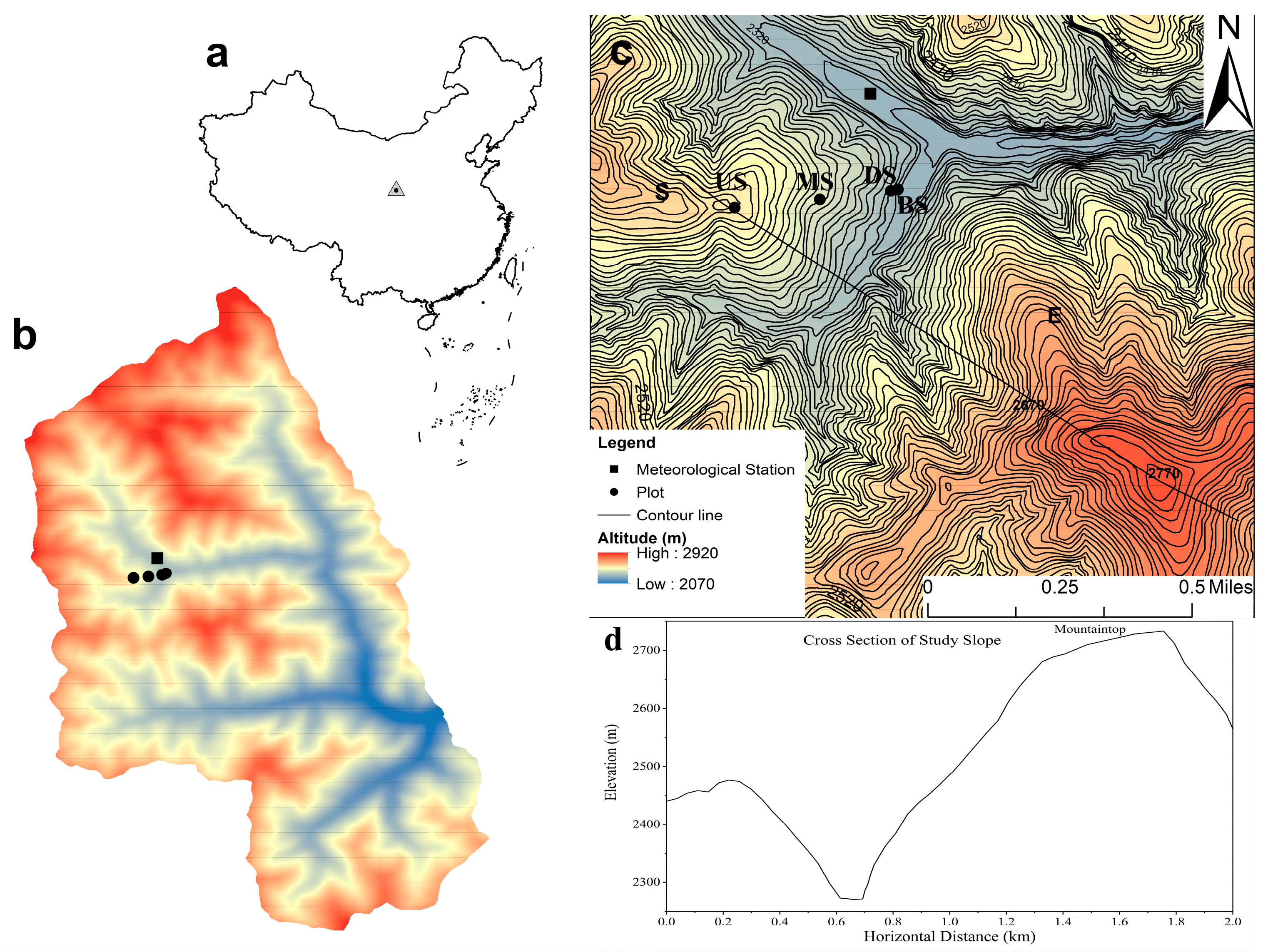
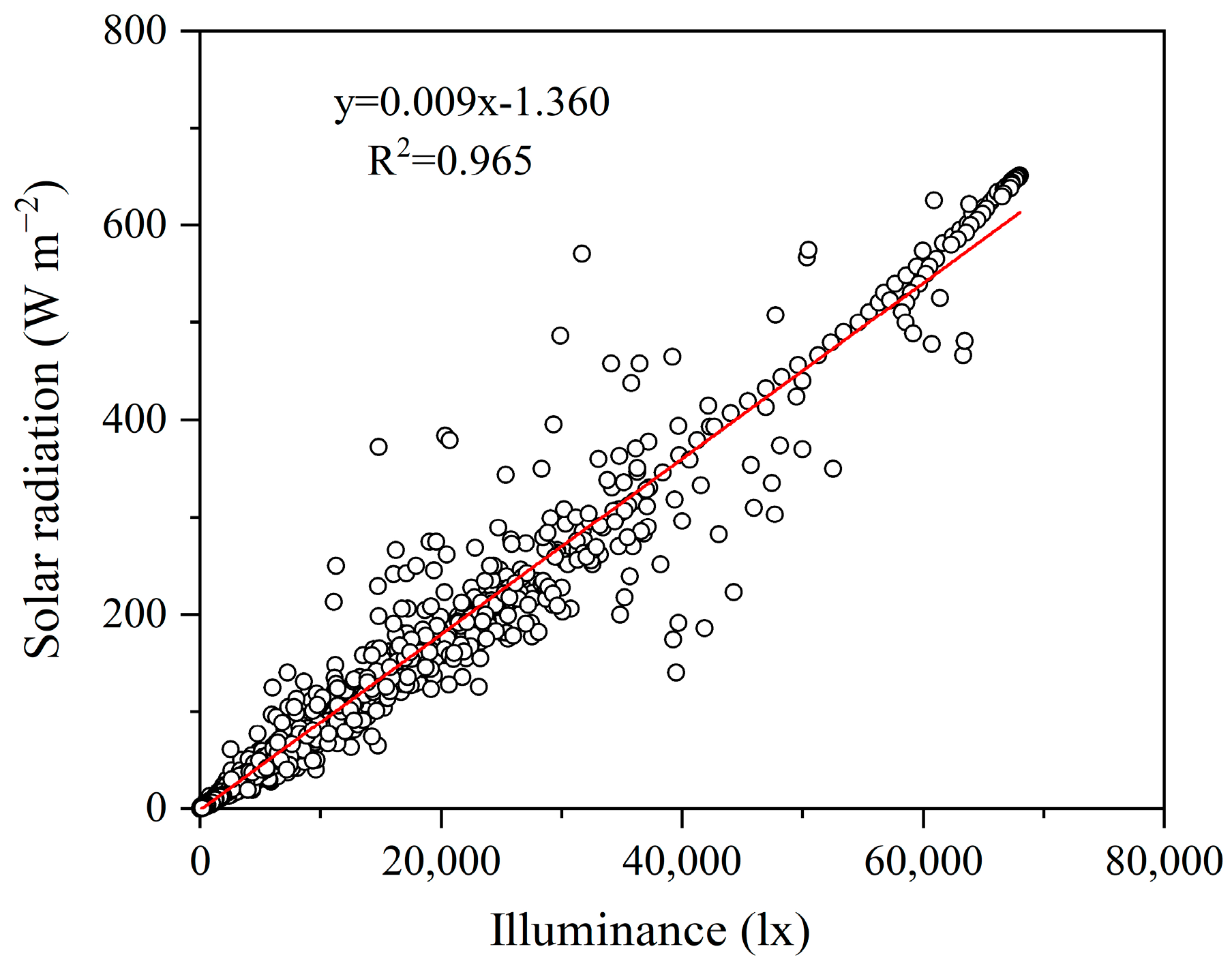
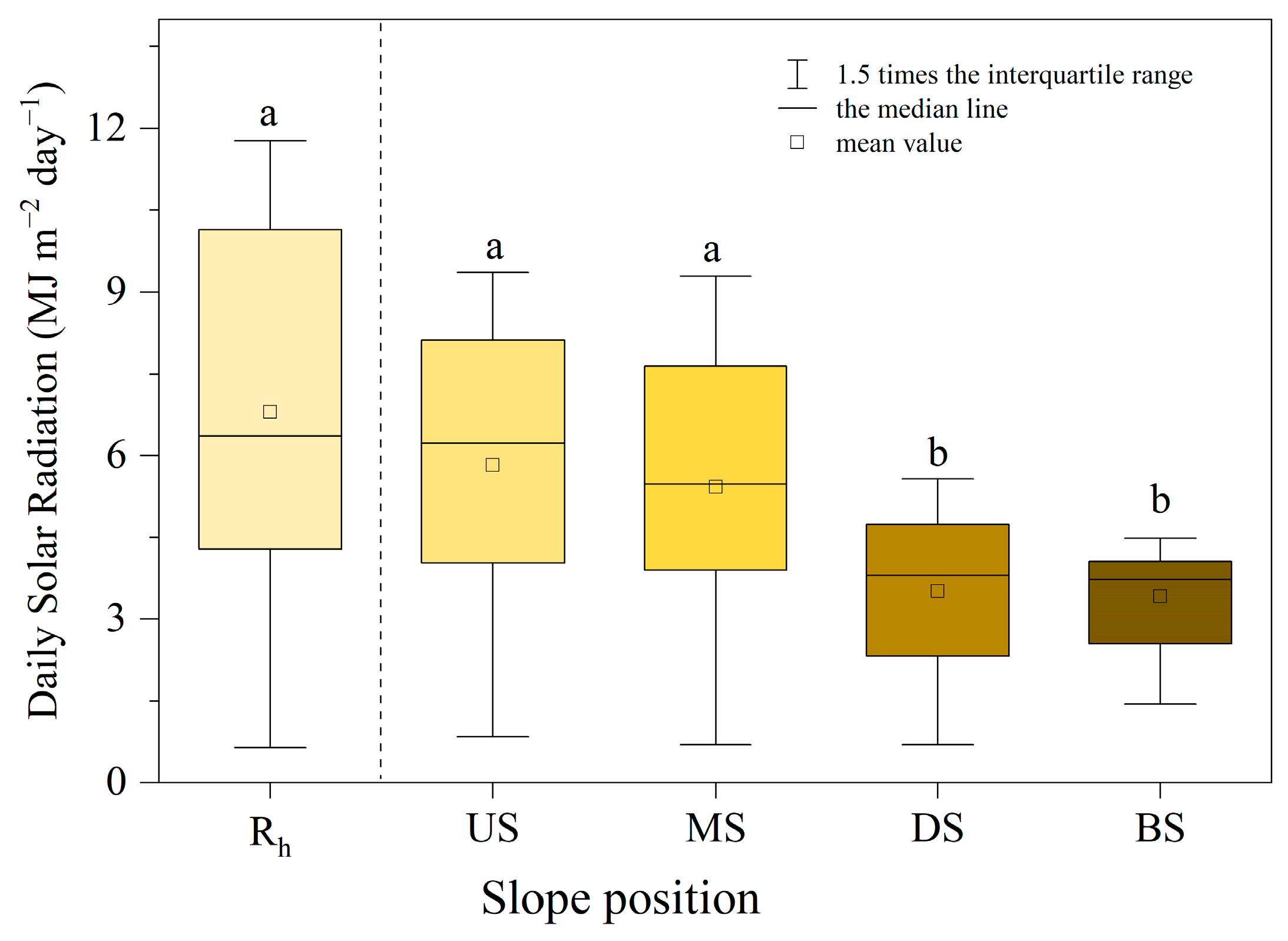

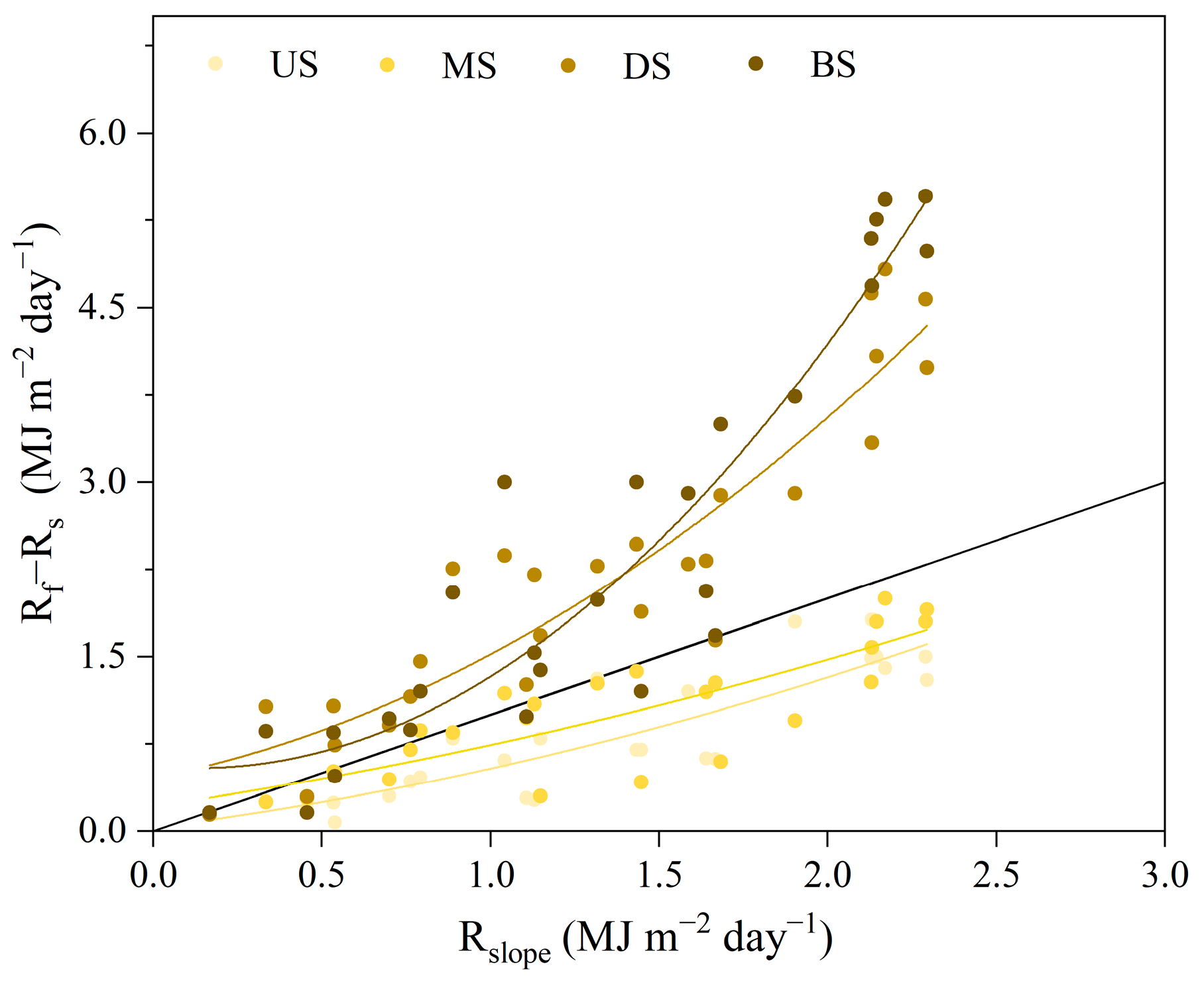
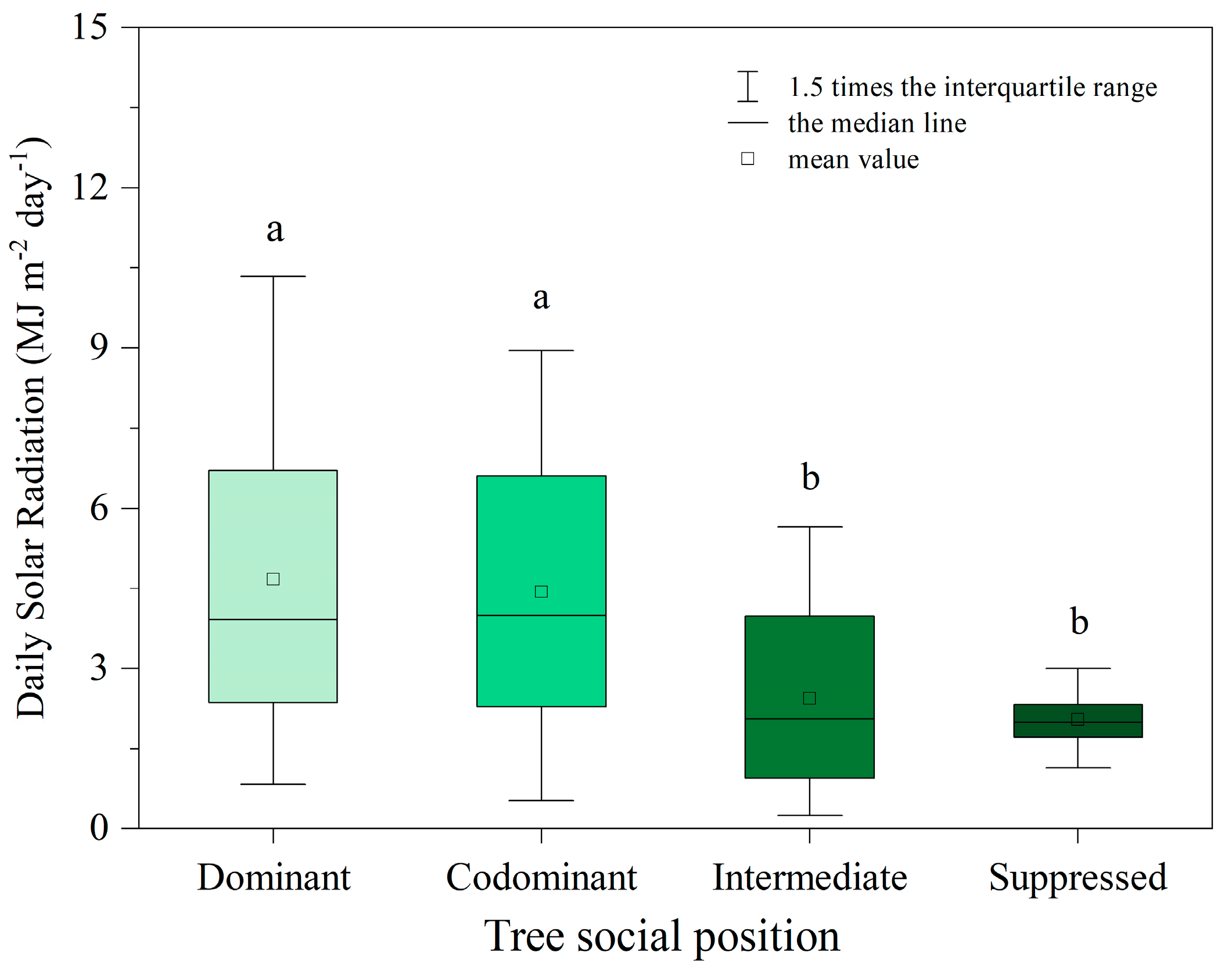


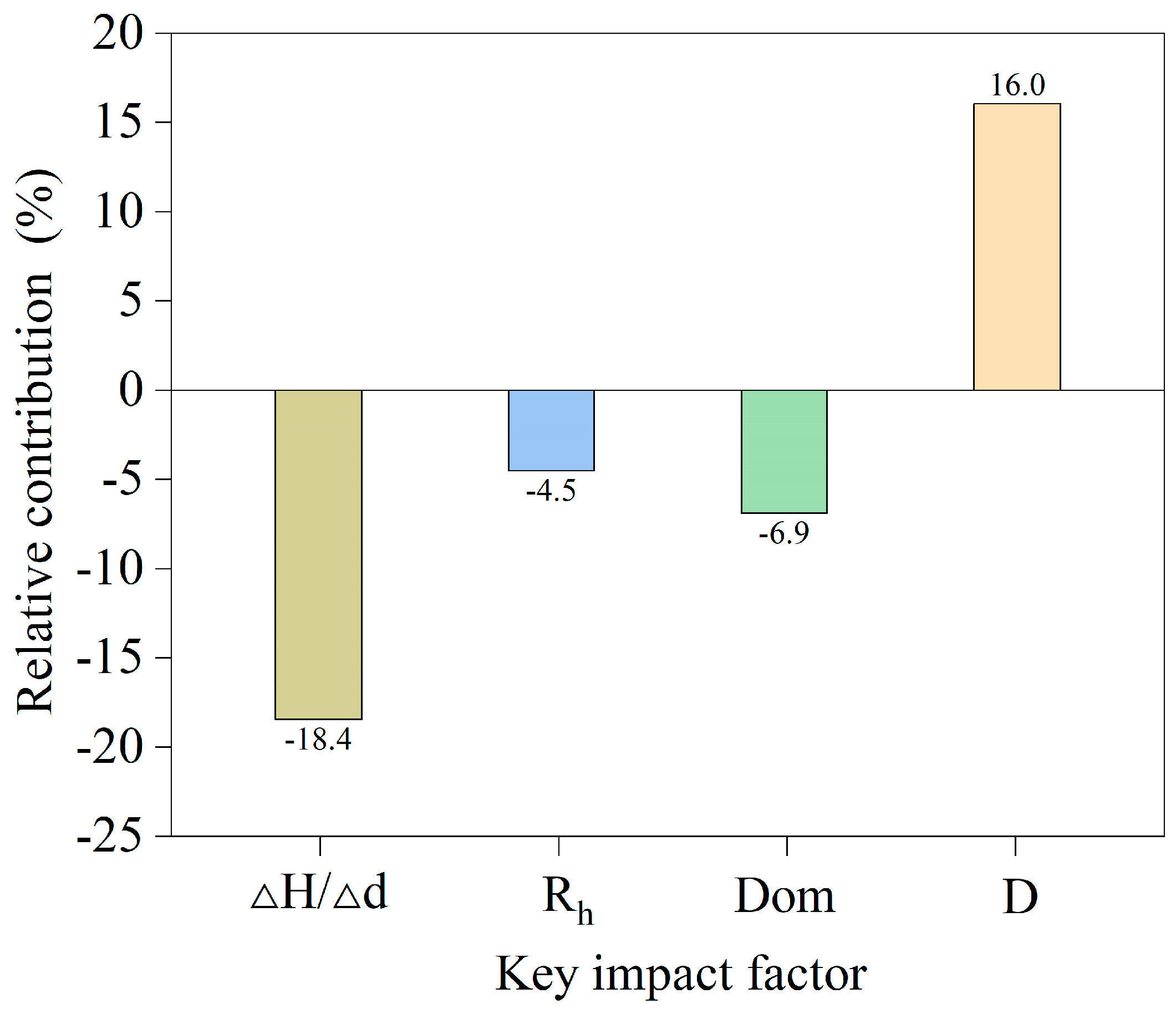

| Plot Positions | Elevation (m) | Slope Gradient (°) | Elevation Difference (ΔH) | Horizontal Distance (Δd) |
|---|---|---|---|---|
| Upper slope (US) | 2471 | 26.3 | 259 | 1501 |
| Middle slope (MS) | 2397 | 26.8 | 333 | 1339 |
| Down slope (DS) | 2293 | 29.0 | 437 | 1092 |
| Bottom slope (BS) | 2273 | 34.9 | 457 | 1050 |
| Plot Positions | Stand Density (Trees ha−1) | Mean Diameter at Breast Height (cm) | Mean Tree Height (m) | Mean Canopy Diameter (m) |
|---|---|---|---|---|
| Upper slope (US) | 856 | 21.83 | 19.4 | 4.5 |
| Middle slope (MS) | 844 | 22.29 | 20.0 | 3.7 |
| Down slope (DS) | 742 | 20.63 | 19.2 | 4.5 |
| Bottom slope (BS) | 711 | 21.40 | 19.5 | 4.4 |
| Tree Social Position Levels | Number of Trees | Mean Diameter at Breast Height (cm) | Mean Tree Height (m) | Mean Canopy Diameter (m) |
|---|---|---|---|---|
| Dominant | 8 | 25.30 ± 1.7 | 21.8 ± 1.8 | 4.9 ± 0.5 |
| Codominant | 40 | 21.19 ± 2.2 | 19.8 ± 1.4 | 4.6 ± 0.4 |
| Intermediate | 31 | 19.16 ± 1.9 | 18.6 ± 1.7 | 4.3 ± 0.6 |
| Suppressed | 12 | 15.40 ± 2.5 | 17.1 ± 2.3 | 3.6 ± 0.5 |
| Tree Social Position Levels | Tree No. | Dom Value | D Value (m) | Diameter at Breast Height (cm) | Tree Height (m) | Canopy Diameter (m) |
|---|---|---|---|---|---|---|
| Dominant | 29 | 0.12 | 4.8 | 25.92 | 21.8 | 5.2 |
| 57 | 0.11 | 4.5 | 24.34 | 21.5 | 4.8 | |
| Codominant | 61 | 0.01 | 3.9 | 21.50 | 19.8 | 4.4 |
| 69 | 0.00 | 3.3 | 21.11 | 19.6 | 4.6 | |
| Intermediate | 43 | −0.04 | 3.0 | 19.53 | 18.5 | 4.2 |
| 44 | −0.04 | 2.9 | 18.82 | 18.4 | 4.0 | |
| Suppressed | 81 | −0.21 | 2.2 | 15.50 | 17.2 | 3.5 |
Disclaimer/Publisher’s Note: The statements, opinions and data contained in all publications are solely those of the individual author(s) and contributor(s) and not of MDPI and/or the editor(s). MDPI and/or the editor(s) disclaim responsibility for any injury to people or property resulting from any ideas, methods, instructions or products referred to in the content. |
© 2023 by the authors. Licensee MDPI, Basel, Switzerland. This article is an open access article distributed under the terms and conditions of the Creative Commons Attribution (CC BY) license (https://creativecommons.org/licenses/by/4.0/).
Share and Cite
Li, J.; Yu, P.; Wan, Y.; Wang, Y.; Liu, B.; Yu, Y. Effects of Topography and Social Position on the Solar Radiation of Individual Trees on a Hillslope in Northwest China. Forests 2023, 14, 561. https://doi.org/10.3390/f14030561
Li J, Yu P, Wan Y, Wang Y, Liu B, Yu Y. Effects of Topography and Social Position on the Solar Radiation of Individual Trees on a Hillslope in Northwest China. Forests. 2023; 14(3):561. https://doi.org/10.3390/f14030561
Chicago/Turabian StyleLi, Jiamei, Pengtao Yu, Yanfang Wan, Yanhui Wang, Bingbing Liu, and Yipeng Yu. 2023. "Effects of Topography and Social Position on the Solar Radiation of Individual Trees on a Hillslope in Northwest China" Forests 14, no. 3: 561. https://doi.org/10.3390/f14030561
APA StyleLi, J., Yu, P., Wan, Y., Wang, Y., Liu, B., & Yu, Y. (2023). Effects of Topography and Social Position on the Solar Radiation of Individual Trees on a Hillslope in Northwest China. Forests, 14(3), 561. https://doi.org/10.3390/f14030561





